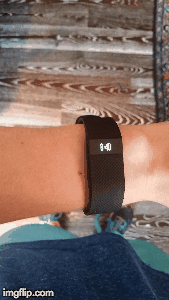
Fitbit Inc. makes what are perhaps the most ubiquitous of the many activity trackers sprung onto the market in the past couple of years.
Fitbit emerged early, starting up in 2007 in San Francisco. The wearable technology craze has opened the door for many companies looking to disrupt the fitness market, normalizing the concept of the quantified self and letting a device auto-tweet your exercise results to your social feeds.
For the past week, I’ve been wearing my very own Fitbit Charge HR (there are various other models ranging in price and features) and tracked my everyday fitness data. The Charge HR is one of the newest Fitbit models, and retails for $179.99. It features a small screen, built-in heart rate monitor and scrolling button. It looks as ordinary as a modern watch, and is intended to sit on your non-dominant wrist.
The screen remains black until you move your arm quickly, at which point the device will display the time. By clicking the button on the side, you can scroll through all of the devices features. These include your steps taken, current heart rate, floors climbed, distance walked and calories burned. Additionally, you can use the device as a stopwatch by briefly holding the same button.

The paired smartphone app gives users the ability to view and understand their data. It also gives them the opportunity to set a ‘silent alarm’ for their device. It’s exactly what it sounds like: the device vibrates instead of emitting noise, resulting in a relatively painless wake up for you and your roommate. The device is also able to display call notifications through Bluetooth. I didn’t take advantage of this feature because I usually have my phone on me, but it seems useful if you’re looking to get off the grid (relatively speaking) for a few hours.

So the main question seems to be: is it worth the investment?
Like most things in life, it depends on who you are. If you’re someone who thrives on goal setting, this device could become a useful asset. If achieving a daily goal would cause nothing but stress and headaches, I’d steer clear of any activity tracker.
The Fitbit is intended to be worn 24 hours a day, with the exception of showering or swimming. As a person who doesn’t normally wear a watch, I definitely noticed the presence of the device on my wrist. It didn’t cause direct discomfort, but after long periods of time I found it to be slightly irritating. As a result, I would sometimes take off my Fitbit to give my wrist a break, leading to less accurate data.
Other than this, I actually found the data provided by my Fitbit to be quite useful. I broke down my major observations here:
| Athletic implications | Daily uses |
| – Heart rate monitor is extremely useful during workouts that require heart rate spikes and recovery- Built in timer limits devices needed during workout
– Makes you conscious of water intake via tracking (avoid dehydration during exercise) – Ability to spot the correlation between sleep quality and athletic performance |
– Heart rate monitor can be a useful tool to monitor stress in daily situations- Serves as a reminder to control portions (easy to log foods and track calories)
– Sleep tracking provides insight into patterns and quality of sleep – Makes logging water intake easy by providing common consumption sizes – Silent alarm makes waking up a breeze without bothering anyone you might share a room with |
Every Fitbit user I came across seemed to be quite pleased with their device, and enthusiastic about the data it provided them with. Another aspect of the Fitbit craze seems to be satisfying an innate competitive craving. When I explained to any Fitbit user that I had just slapped the device on myself the other day, their response was usually, “how many steps are you at today?” Or alternatively, “what’s your heart rate at right now?”
Overall, it seems to me that the Fitbit can be extremely handy if you have the right mindset for it. It provides you with a lot of data, and whether that is useful or not is up to you to decide. Personally, I enjoyed what the Fitbit had to offer. I found it served as a constant reminder to be more conscious of certain lifestyle decisions.
Whether it was logging my meals, tracking my sleep, or following my heart rate I enjoyed the aspect of ‘tracking’ my daily activities. With that said, I don’t think I could commit to the Fitbit lifestyle for more than a few days at a time. It takes a lot of energy, and I’m happy to take a break every so often.
I’d say the Charge HR is a good investment, as long as you know what you’re signing up for.





